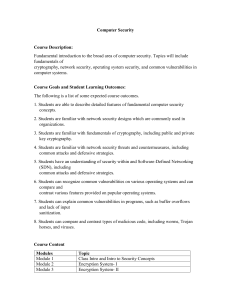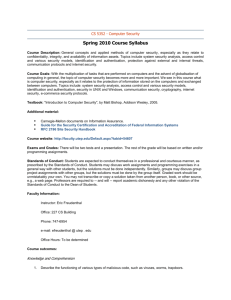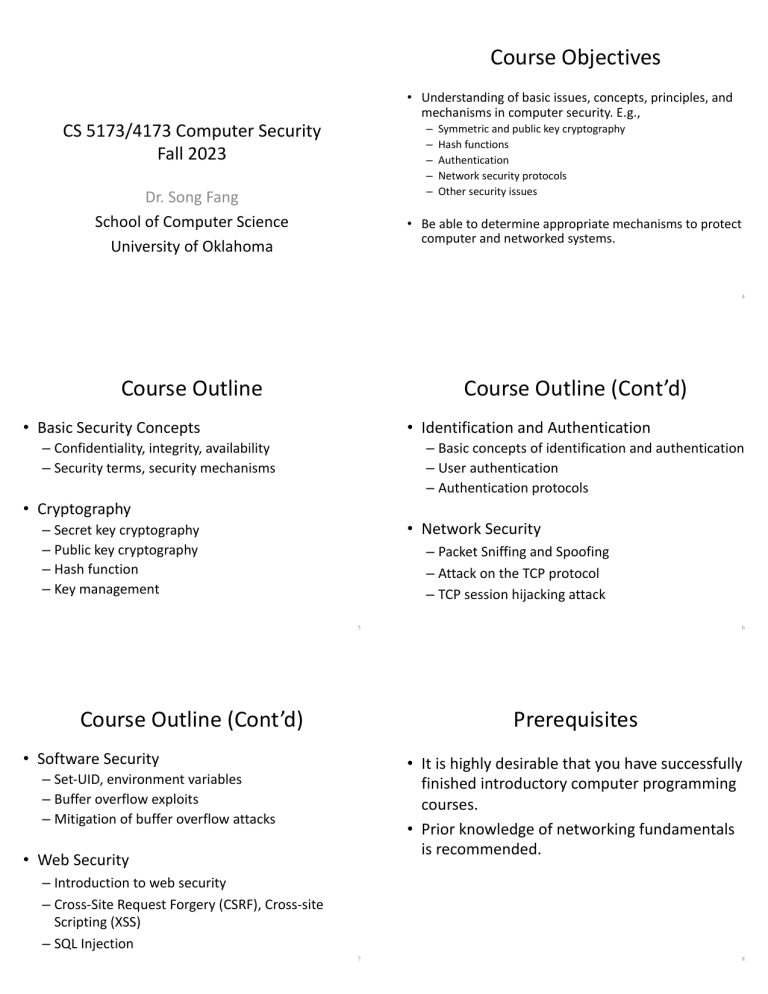
Course Objectives • Understanding of basic issues, concepts, principles, and mechanisms in computer security. E.g., CS 5173/4173 Computer Security Fall 2023 – – – – – Dr. Song Fang School of Computer Science University of Oklahoma Symmetric and public key cryptography Hash functions Authentication Network security protocols Other security issues • Be able to determine appropriate mechanisms to protect computer and networked systems. 4 Course Outline Course Outline (Cont’d) • Basic Security Concepts • Identification and Authentication – Confidentiality, integrity, availability – Security terms, security mechanisms – Basic concepts of identification and authentication – User authentication – Authentication protocols • Cryptography • Network Security – Secret key cryptography – Public key cryptography – Hash function – Key management – Packet Sniffing and Spoofing – Attack on the TCP protocol – TCP session hijacking attack 5 Course Outline (Cont’d) 6 Prerequisites • Software Security • It is highly desirable that you have successfully finished introductory computer programming courses. • Prior knowledge of networking fundamentals is recommended. – Set-UID, environment variables – Buffer overflow exploits – Mitigation of buffer overflow attacks • Web Security – Introduction to web security – Cross-Site Request Forgery (CSRF), Cross-site Scripting (XSS) – SQL Injection 7 8 Textbook Grading • Quizzes: 10% (6 in total and the lowest will be dropped) • One project: 25% • Labs: 30% (4173); 25% (5173) (SEED labs) (5 in total and the lowest will not be dropped) • Final: 35% (4173); 30% (5173) • CS 5173 only: In-class presentation (10%) • Suggested textbook – Charlie Kaufman, Radia Perlman, and Mike Speciner, Network Security: Private Communication in a Public World, 2nd Edition, Prentice Hall, ISBN: 0-13-046019-2. – Wenliang Du. Computer Security: A Hands-on Approach. 3rd Edition, 2022. 9 Policies on incomplete grades and late assignments In-class Presentation • • • • • 10 A paper list will be provided on Canvas Each student selects a paper 18-minute presentation + 5-minute Q&A Slides must be uploaded for grading as well Peer review (2 extra points for all students) • Lab deadlines will be hard. • Late submission will be accepted with a 15% reduction in grade each day they are late by (up to a maximum of 2 days). 11 Policies on Absences and Scheduling Makeup Work 12 Academic Integrity • Make-up exams will not normally be permitted. Exceptions will be made if a student presents a police report or a doctor's note that show some emergency situation. • Events such as going on a business trip or attending a brother's wedding are not an acceptable excuse for not taking an exam at its scheduled time and place. 13 • A student must complete his/her tests, projects and assignments on his/her own. Example cheating behaviors include but not limited to: direct and indirect plagiarizing another student’s work or online resources. • For student’s guide to Academic Integrity, please visit http://integrity.ou.edu/students.html 14 Why This Course? • Increased volume of security incidents CIS 5173/4173 Computer Security Topic #1. Basic Security Concepts 16 Why This Course? Why This Course? • Increased volume of security incidents Ø – Malware: Virus, worm, spyware – Spam – Botnet – DDoS attacks – Phishing –… Meltdown and Spectre are security vulnerabilities that affect the majority of modern CPUs ü ü Ø • Increased volume of security incidents • Security threats Meltdown breaks the most fundamental isolation between user applications and the operating system => allows a program to access the memory, and thus also the secrets, of other programs and the OS. (specific to Intel CPUs) Spectre breaks the isolation between different applications and allows an attacker to trick error-free programs, which follow best practices, into leaking their secrets. Discovered in 2017 and announced in January 2018 17 Contributing Factors 18 Contributing Factors (Cont’d) • Lack of awareness of threats and risks of information systems • Lack of security in TCP/IP protocol suite – Most TCP/IP protocols not built with security in mind – Work is actively progressing within the Internet Engineering Task Force (IETF) – Security measures are often not considered until an Enterprise has been penetrated by malicious users – The situation is getting better, but … • Complexity of security management and administration • (Historical) Reluctance to invest in security mechanisms – Security is not just encryption and authentication – The situation is improving • Example: Windows 95 à Windows 2000 à Windows XP à Windows XP SP2 à Windows Vista à Windows 7 à Windows 8 à Windows 10 – But there exists legacy software • Wide-open network policies • Software vulnerabilities – Example: buffer overflow vulnerabilities – We need techniques and tools to better protect software security • Cracker skills keep improving – Many Internet sites allow wide-open Internet access 19 20 Security Objectives Security Objectives (CIA) • Confidentiality — Prevent/detect improper disclosure of information • Integrity — Prevent/detect improper modification of information • Availability — Prevent/detect improper denial of access to services provided by the system • These objectives have different specific interpretations in different contexts Confidentiality (Secrecy) Integrity Availability (Denial of Service) 21 22 Commercial Example Military Example • Confidentiality — An employee should not know the salary of his manager • Integrity — An employee should not be able to modify the employee's own salary • Availability — Paychecks should be printed on time as stipulated by law • The target coordinates of a missile should not be improperly disclosed Confidentiality • The target coordinates of a missile should not be improperly modified Integrity • When the proper command is issued, the missile should fire Availability 23 24 Achieving Security Security Policy • Security policy — What? • Security mechanism — How? • Security assurance — How well? Organizational Policy 25 Automated Information System Policy 26 Security Mechanisms Security Services • Security functions are typically made available to users as a set of security services through APIs or integrated interfaces • Confidentiality: protection of any information from being exposed to unintended entities. • In general three types – Prevention • Example: Access control – Information content. – Parties involved. – how they communicate, how often, etc. – Detection • Example: Auditing and intrusion detection • Authentication: assurance that an entity of concern or the origin of a communication is authentic - it’s what it claims to be or from • Integrity: assurance that the information has not been tampered with – Tolerance • Example: Byzantine agreement Good prevention and detection both require good authentication as a foundation 27 28 Security Services (Cont’d) Security Assurance • Non-repudiation: offer of evidence that a party is indeed the sender or a receiver of certain information • Access control: facilities to determine and enforce who is allowed access to what resources, hosts, software, network connections • Monitor & response: facilities for monitoring security attacks, generating indications, surviving (tolerating) and recovering from attacks • How well your security mechanisms guarantee your security policy • Everyone wants high assurance • High assurance implies high cost 29 30 Security Tradeoffs – May not be possible • Trade-off is needed Security by Obscurity • Security by obscurity Security – If we hide the inner workings of a system it will be secure Functionality • More and more applications open their standards (e.g., TCP/IP, 802.11) • Widespread computer knowledge and expertise COST Ease of Use 31 32 Security by Legislation Threat-Vulnerability • Security by legislation says that if we instruct our users on how to behave we can secure our systems • For example • Threats — Possible attacks on the system • Vulnerabilities — Weaknesses that may be exploited to cause loss or harm • Requires assessment of threats and vulnerabilities – Users should not share passwords – Users should not write down passwords – Users should not type in their password when someone is looking over their shoulder • User awareness and cooperation is important, but cannot be the principal focus for achieving security 33 Threat Model and Attack Model • Threat model and attack model need to be clarified before any security mechanism is developed • Threat model – Assumptions about potential attackers – Describes the attacker’s capabilities • Attack model – Assumptions about the attacks – Describe how attacks are launched 35 34
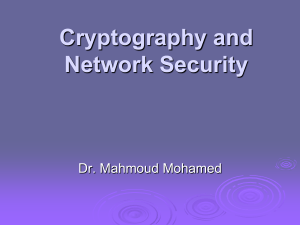
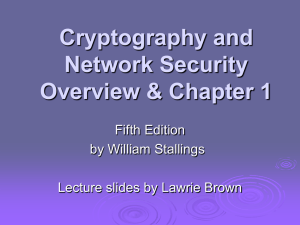

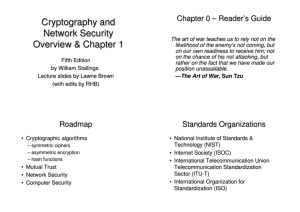

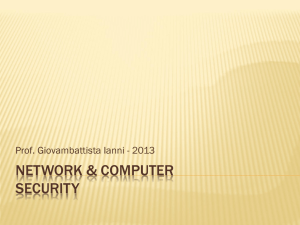
![Systems Assurance [Opens in New Window]](http://s3.studylib.net/store/data/007522633_2-e364c8f93e26286779d02c826b323ed6-300x300.png)

